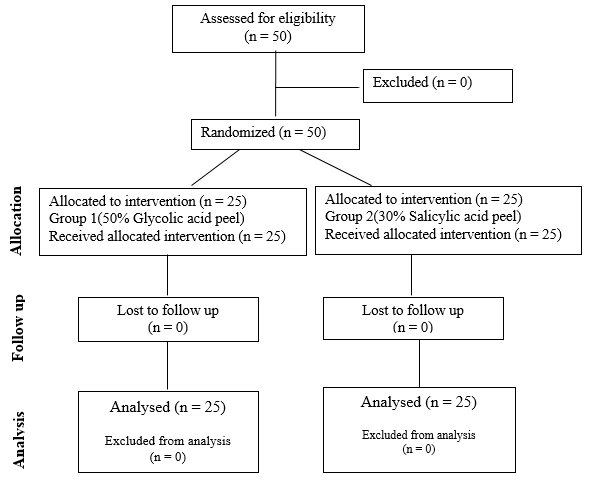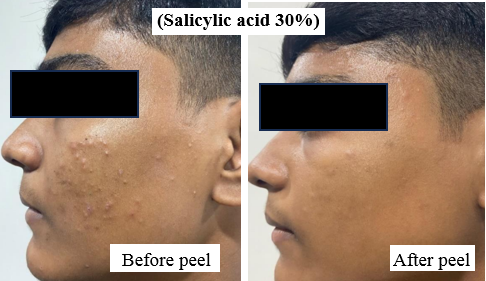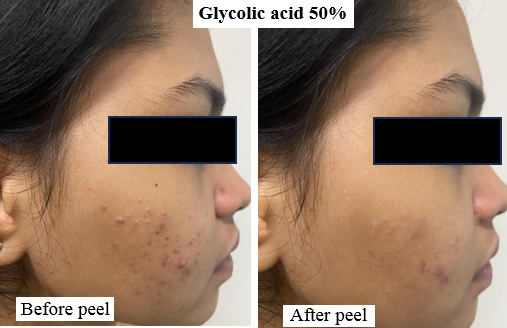- Received December 21, 2024
- Accepted January 23, 2025
- Publication February 08, 2025
- Visibility 45 Views
- Downloads 1 Downloads
- DOI 10.18231/j.ijced.2025.018
-
CrossMark
- Citation
A comparative study of 30% salicylic acid peel and 50% glycolic acid peel in mild to moderate acne vulgaris
Introduction
Acne vulgaris is a common dermatological condition affecting the pilosebaceous units, predominantly occurring during adolescence but often persisting into adulthood. It is characterised by comedones, papules, pustules, and occasionally nodules or cysts, can have a substantial influence on a person's self-esteem and quality of life.[1], [2] Acne vulgaris is widespread among teenagers and young adults. Its prevalence rates are believed to range from 35% to more than 90% among adolescents. [3]
Some of the key mechanisms involved in acne development include disturbed sebaceous gland activity associated with hyper seborrhoea and changes in sebum fatty acid composition, dysregulation of the hormone microenvironment, interaction with neuropeptides, follicular hyperkeratinization, inflammation induction, and innate and adaptive immunity dysfunction. [4] Acne vulgaris is difficult to treat because of its complex aetiology. Topical retinoids, systemic and topical antibiotics, benzoyl peroxide, azelaic acid, and systemic isotretinoin are among the current treatments. Topical dapsone, taurine bromamine, resveratrol, chemical peels, optical therapies, and complementary and alternative medicine are examples of adjunctive and/or developing techniques. [5]
Chemical peels are becoming more and more acknowledged as a minimally invasive, successful acne treatment option, especially for mild to moderate cases. These substances target important pathogenic variables such as follicular clogging, excess sebum, and inflammatory processes by causing a regulated chemical exfoliation of the epidermis. Because of their proven safety and effectiveness profiles, salicylic acid (SA) and glycolic acid (GA) are the most commonly utilised chemical peels. Salicylic acid is lipid-soluble, it can efficiently enter sebaceous follicles. It works very well for inflammatory and comedonal acne because of its keratolytic, comedolytic, and anti-inflammatory properties. The main mechanisms of action of water-soluble glycolic acid include the disruption of corneocyte cohesiveness, the enhancement of dermal remodelling, and the promotion of epidermal exfoliation. [6], [7] With this background we aimed to compare the effectiveness of Salicylic acid peel 30% and Glycolic acid peel 50% peels in patient with mild to moderate Acne vulgaris in our region with cultural variations and skin reactions to these treatments.
Materials and Methods
A randomized controlled trial was conducted among 50 patients with Acne vulgaris presenting to Dermatology OPD at a Tertiary care hospital, in Tamil Nadu. With reference to the article Shah et al in Mumbai, India the prevalence of acne is 0.74%. [8] The estimated sample size to compare the two groups(50% Glycolic acid, 30% salicylic acid) was calculated to be 50, 25 in each group with confidence interval of 95% and absolute precision d = 3, using the formula 4pq/d2. Patients aged between 18 to 40 years with mild to moderate acne vulgaris and both genders were included in the study. Patients with active infections, known hypersensitivity, and pregnant & lactating females were excluded from the study. [9] Patients were divided into two groups with 25 each. Glycolic acid 50% peel was applied on the lesions for Group A patients and observed for 2-3 minutes until endpoint -erythema was observed and neutralized with 10% sodium bicarbonate. Salicylic acid 30% peel was applied on the lesion by the dermatologist and observed for 3-5 minutes until endpoint pseudo-frost was observed and washed with water for Group B patients. Subjects in Group A & B applied sunscreen regularly and the procedure was repeated every two weeks. Under supervision for a maximum of five sessions. The Global Acne Severity Score assesses acne severity by considering lesion counts and their locations. Location factors are assigned as follows: 2 for the forehead, right cheek, and left cheek each; 1 for the nose and chin each; and 3 for the chest and upper back. Lesion types are rated on a scale where no lesions = 0, comedones = 1, papules = 2, pustules = 3, and nodules = 4. The total score is determined by multiplying the lesion count in each area by its location factor and summing the results. Severity levels are categorized as 0 (none), 1–18 (mild), 19–30 (moderate), 31–38 (severe), and over 39 (very severe). Serial Clinical photographs & acne severity scoring system were taken with the subject’s consent to observe the improvement seen in acne vulgaris after the peel.

Results
|
Variables |
Group A Glycolic acid 50% (n = 25) |
Group B Salicylic acid 30% (n = 25) |
|
|
Age (in years) |
22.4 ± 2.8 |
23.1 ± 3.7 |
|
|
Gender |
Male |
7 |
6 |
|
Female |
18 |
19 |
The demographic characteristics of patients are shown in [Table 1]. The mean & SD of age among the patients with Glycolic acid 50% and Salicylic acid 30% are 22.4 ± 2.8 and 23.1 ± 3.7 years. In both the groups female participants were more than male participants.
|
Session |
Group A Glycolic acid 50% (n = 25) |
Group B Salicylic acid 30% (n = 25) |
p-value |
|
(Baseline) |
27.6 ± 41.5 |
25.6 ± 19.2 |
0.3300 |
|
(Week 2) |
25.6 ± 28.6 |
19.7 ± 16.1 |
0.3732 |
|
(Week 4) |
23.3 ± 24.8 |
15.3 ± 11.6 |
0.2073 |
|
(Week 6) |
22.9 ± 19.1 |
13.2 ± 11.2 |
0.0327* |
|
(Week 8) |
20.9 ± 21.6 |
11.1 ± 10 |
0.0450* |
The [Table 2] shows the mean & SD of comedones, papules, and pustules (Grade I & II) numbers from the beginning to the end of the treatment. The initial numbers were almost equal in both the groups which are 27.6 ± 41.5 (Glycolic acid 50%) and 25.6 ± 19.2 (Salicylic acid 30%). There was a significant reduction in the number of comedones, papules, and pustules from 4th week in both Group A and Group B. In the 8th week, the mean & SD of Group A and Group B are 20.9 ± 21.6 and 11.1 ± 10. At the end of the treatment patients who used Salicylic acid 30% had better outcome than the patients who used Glycolic acid 50%. On comparing both the groups we found statistically significant at week 6 (0.0327) and week 8 (0.0450).
|
Complications |
Group A Glycolic acid 50% (n = 25) |
Group B Salicylic acid 30% (n = 25) |
|
Burning |
8 |
3 |
|
Itching |
4 |
9 |
|
Redness |
3 |
5 |
|
Scaling |
4 |
4 |
|
No complications |
6 |
4 |
On comparing complications in Group A and Group B, the patients in both groups had burning, itching, redness, and scaling. Patients who used Salicylic acid 30% had significantly decreased the acne lesions and had skin whitening effects.
Discussion
In this study the number of comedones, papules and pustules were statistically significantly reduced during treatment in both the group of patients. In both groups, the longer the peeling times, the more the number of lesions was reduced. Facial sebum secretion has been reported to be significantly reduced after peels containing 50% Glycolic acid and 30% salicylic acid, which contribute to the effectiveness of these agents in acne improvement. Among this patients who used 30% salicylic acid had better outcomes.
A similar comparative study by Pavithra S et al was done with 70% GA peel (group 1) and 30% SA peel (group 2) with 30 patients in each group. at the initial phase, the mean & SD of groups 1 & 2 are 26.30 ± 5.91 and 25.73 ± 5.11 whereas in our study which are 27.6 ± 41.5 (Glycolic acid 50%) and 25.6 ± 19.2 (Salicylic acid 30%) which is almost same. In both the studies the mean acne lesional count of both groups was reduced and patients who used salicylic acid had better outcomes and they were found to be significant at 6th & 8th week sessions. [10] Garg VK et al conducted a similar study and found both Glycolic Acid Peels and Salicylic–Mandelic Acid Peels were effective in active Acne Vulgaris. Salicylic–Mandelic Acid Peels had a higher efficacy for most active acne lesions and hyperpigmentation which is consistent with our study findings. In the same previous study, side effects were also lesser with Salicylic–Mandelic acid whereas in our study we found fewer complications among the patients who used Glycolic acid. [11]
Manjhi M et al did a study with 50 % Glycolic Acid Peel and 30 % Salicylic Acid Peel in Mild to Moderate Acne. At 3rd follow-up, the mean & SD of the number of acnes with Glycolic Acid and 30 % Salicylic Acid are 5.50 ± 3.91 and 2.20 ± 2.63 which showed 30 % Salicylic Acid is better than Glycolic Acid which is consistent with our study findings. [12]


Other contrary studies by Sarkar R et al, Sharma P et al and Mohamed RH et al showed both SA and GA peels showed significant improvements in reducing acne lesions, but their mechanisms of action differ. Salicylic acid, a beta-hydroxy acid (BHA), is lipid-soluble and penetrates sebaceous follicles effectively. This makes it particularly suitable for targeting comedones and inflammatory lesions. Glycolic acid, an alpha-hydroxy acid (AHA), promotes epidermal exfoliation, enhances collagen synthesis, and improves post-inflammatory hyperpigmentation. [13], [14], [15]
Conclusion
This comparative study of 30% salicylic acid peel and 50% glycolic acid peel in mild to moderate acne vulgaris demonstrates that both chemical peeling agents are effective in treating acne, hyperpigmentation and scarring, enhancing skin texture and minimizing superficial scars with good compliance. While both treatments showed overall improvements in acne grading, salicylic acid peels had significantly reduced numbers of acne lesions and improved post acne pigmentation by its anti inflammatory and skin whitening effects. The patient's skin type, the severity of their acne, and their treatment objectives should all be taken into account when choosing between the two medications. To more thoroughly assess the long-term effectiveness and safety profiles of various peeling agents, further extensive research with bigger sample sizes including diverse demographics to assess different age groups, skin types and ethnicities are advised.
Source of Funding
None.
Conflict of Interest
None.
References
- AL Zaenglein. Acne vulgaris. N Engl J Med 2018. [Google Scholar]
- N Hazarika. Acne vulgaris: new evidence in pathogenesis and future modalities of treatment. J Dermatolog Treat 2021. [Google Scholar]
- AH Sutaria, S Masood, HM Saleh, J Schlessinger. Acne Vulgaris. StatPearls [Internet] 2023. [Google Scholar]
- SM Tuchayi, E Makrantonaki, R Ganceviciene, C Dessinioti, SR Feldman, CC Zouboulis. Acne vulgaris. Nat Rev Dis Primers 2015. [Google Scholar] [Crossref]
- T Simonart. Newer approaches to the treatment of acne vulgaris. Am J Clin Dermatol 2012. [Google Scholar]
- HS Lee, IH Kim. Salicylic acid peels for the treatment of acne vulgaris in Asian patients. Dermatol Surg 2003. [Google Scholar]
- C Kaminaka, M Uede, H Matsunaka, F Furukawa, Y Yamomoto. Clinical evaluation of glycolic acid chemical peeling in patients with acne vulgaris: a randomized, double-blind, placebo-controlled, split-face comparative study. Dermatol Surg 2014. [Google Scholar]
- N Shah, R Shukla, P Chaudhari, S Patil, A Patil, N Nadkarni. Prevalence of acne vulgaris and its clinico-epidemiological pattern in adult patients: Results of a prospective,observational study. J of Cosmetic Dermatology 2008. [Google Scholar]
- TT Trang, MB Anh. Grading system of acnes vulgaris. J Med Pharm 2024. [Google Scholar] [Crossref]
- S Pavithra, K Gopalakrishnan, J Shanmugam. Efficacy of 70% Glycolic Acid Peel versus 30% Salicylic Acid Peel in the Treatment of Mild to Moderate Acne Vulgaris: A Retrospective Study. J Clin Diagn Res 2022. [Google Scholar]
- VK Garg, S Sinha, R Sarkar. Glycolic acid peels versus salicylic-mandelic acid peels in active acne vulgaris and post-acne scarring and hyperpigmentation: a comparative study. Dermatol Surg 2009. [Google Scholar]
- M Manjhi, P Yadav, A Yadav, V Sagar, V Ramesh. A Comparative Study of 50 % Glycolic Acid Peel and 30 % Salicylic Acid Peel in Mild to Moderate Acne - A Split Face Study. J Evid Based Med Healthc 2020. [Google Scholar]
- R Sarkar, S Ghunawat, VK Garg. Comparative Study of 35% Glycolic Acid, 20% Salicylic-10% Mandelic Acid, and Phytic Acid Combination Peels in the Treatment of Active Acne and Postacne Pigmentation. J Cutan Aesthet Surg 2019. [Google Scholar]
- P Sharma, A Shah, AS Dhillon. Study of glycolic acid and salicylic acid peels as a sole therapy in treatment of acne vulgaris. Int J Med Res Rev 2016. [Google Scholar]
- RH Mohamed, MH Khater, EM Khater. Study of buffered 50% glycolic acid and 0.5% salicylic acid solution in acne vulgaris. Egypt J Hospital Med 2021. [Google Scholar]
